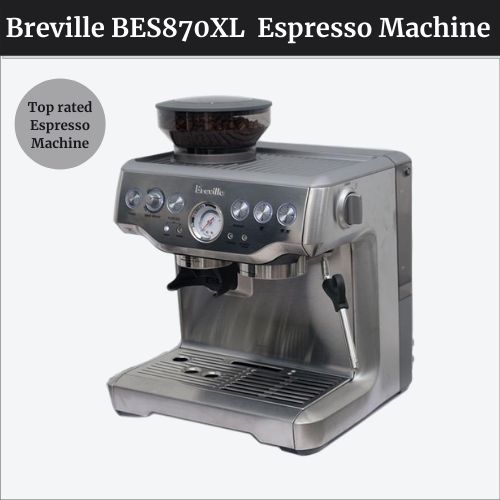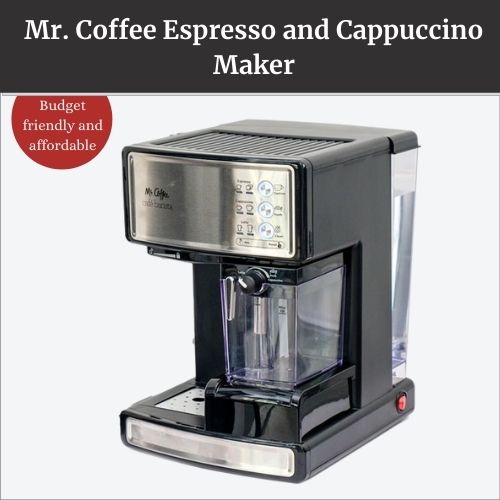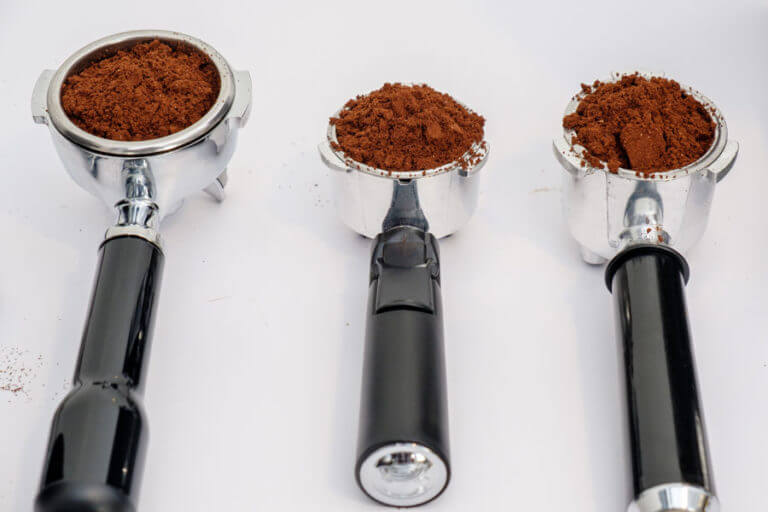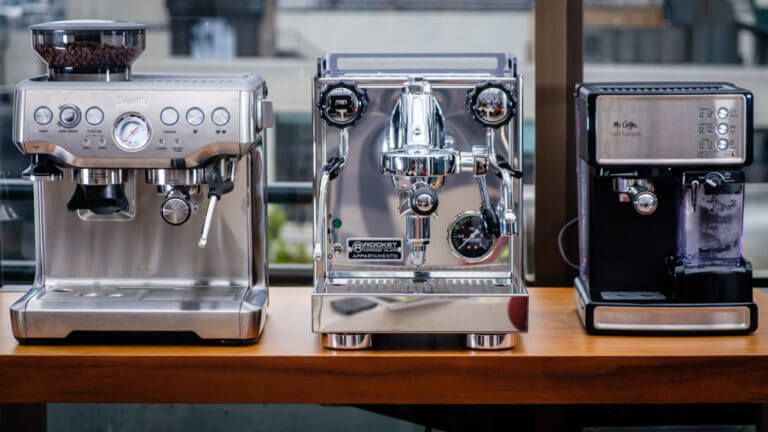After countless hours of research, review, trials and comparison of a wide range of espresso machines and brewing coffee at home, we are certain the best espresso machine in 2022 is the Breville BES870XL Barista Express Espresso Machine. This is because it is suitable for beginners, has lots of functions to make brewing easy and is easy to use.
There’s a reason we call the best espresso machines “great home barista machines”. A good home espresso machine can help you get your latte or cappuccino fixed right in the comfort of your kitchen.

An espresso machine brews coffee by forcing pressurized water near boiling point through a “puck” of ground coffee and a filter in order to produce a thick, concentrated coffee called espresso. Espresso machines are of different types, shapes and sizes.
We took real consumer reviews, examined espresso machine consumer reports and spoke with three home baristas before testing different machines from popular brands such as Breville, Ascaso, Mr. Coffee, Rocket and Gaggia.
The Top 3 Best Rated Home Espresso Machines in 2022
These are the top best espresso machines to buy in 2022:
- Best home espresso machine overall: Breville BES870XL Barista Express Espresso Machine.
- Best professional espresso machine: Rocket Espresso Appartamento Espresso Machine.
- Best affordable and cheap: Mr. Coffee Cafe Barista Espresso and Cappuccino Maker.
Caffè Espresso translates to “pressed-out coffee.” It’s what happens when you force hot water through finely ground coffee beans. This brewing method is challenging to master, as slight variations in pressure and temperature can produce an extremely unpalatable shot.
For this reason, the best espresso machine makes it easy for beginners to extract a rich flavor from its beans, and offers a complex balance of sweet, sour, and bitter.
To help you make a guided decision when shopping for an espresso maker, we talked to three Baristas and two coffee and espresso machine experts, then tested 5 bestselling espresso machines to see which stood out. In this home espresso machine reviews, tested consumer ratings and buying guide, you will know which espresso machine is best for beginners and professional home Baristas after rigorous testing, and learn how to choose the best espresso maker for amazing coffee at home.
We have shortlisted the top-quality espresso makers for beginners and professional home baristas below.
Here then is a reviewed list of the best espresso machines:
1. Breville BES870XL Barista Express Espresso Machine – Best overall
The best entry level espresso machine for beginners

Features:
- Automation: Super Automatic
- Drive Type: Pump
- Features: With Grinder, With Steam Wand
- Water tank size: 2.9 quarts
- Pod Type: Cappuccino
What we like
- It’s an all-in-one machine.
- Great functionality to aid brewing beginners.
- Easy to customize.
What we don’t
- Unable to grind dark roasts. You would need a separate grinder.
Why we picked Breville the Barista Express espresso machine as the best overall for beginers
It’s an all-in-one machine.
The Breville the Barista Express comes with everything you need to pull a great espresso. A built-in grinder lets you adjust grind coarseness, and changing the amount of ground coffee that you want in your shot is easy. To do that, you just have to turn a dial or press the portafilter firmly against the dispensing cradle.
For ease of use, there’s a button at the back that allows you to dose as much or as little coffee as you wish.
Cushion for beginning technique.
The Breville is technically a semi-automatic espresso maker, since it requires you to dose and tamp your own shots, but we found it more forgiving than true automatics.
The dual-wall filter baskets in the Brevilles machine (in addition to two standard single-wall baskets) add extra pressure, and provide a little forgiveness for beginners’ mistakes in either grinding the beans or tamping the shot.
Easy to customize.
For first-time espresso machine owners, the Breville offers the perfect balance between hand-holding and customization. You’re in charge of basic steps like measuring out and pulling your shot, but the Breville makes it easy to adjust things like the coarseness of your grind and the amount of espresso.
The user manual walks you through every step of the brewing process, and altering the default settings is easy, thanks to a display panel that clearly labels all buttons and lights.
Our shots were beautifully layered and gave us truly gorgeous colors as the espresso flowed out of the portafilter.
What you should know and point to consider
Hiccups in milk steaming.
Steaming milk is straightforward, utilizing a simple on/off switch, and we got some stunning microfoam. However, the process isn’t flawless.
You’ll need to prime the steam wand prior to using it on your milk, or else water will drip into your pitcher as the steam begins to sputter out. This sputtering caused us to have a few larger bubbles, frowned upon by hardcore espresso lovers.
Unable to grind dark roasts.
While we love the all-inclusive features of the Breville, there’s one thing it can’t do on its own, at least not without a hefty fix. If you love dark roasts, any machine that features an internal grinder is off-limit.
The oily shine characteristic of dark roasts builds up in any grinder, but while you can disassemble and clean standalone grinders, this is rarely an option for internal ones. The residual oil left in an internal grinder will, at best, give future shots a rancid flavor. At worst, the oil will clog the grinder.
If you want to brew dark roasts on the Breville, plan on buying a separate grinder.
2. Rocket Espresso Appartamento Espresso Machine – Best professional espresso machine for home baristas
The best prosumer espresso machine and high-quality Italian espresso maker for amazing coffee at home

Features:
- Automation: Semi-Automatic
- Drive Type: Pump
- Features: For home and commercial use, With steam wand
- Water tank size: 1.9 quarts
Why we picked it
Phenomenal espressos and lattes.
If you’re ready to drop serious money on a high-quality espresso machine that produces smooth, complex shots, our pick is the Rocket Espresso Appartamento Espresso Machine. The Appartamento is a high-quality Italian espresso machine designed for home baristas to make great tasting coffee and espresso at home.
The machine lets you cycle quickly between steaming milk and pulling espresso: It uses a heat exchanger, rather than the more typical thermoblock, which means that the Rocket’s boiler heats all the way up to milk-steaming temperatures when you first turn it on.
When you’re ready to pull shots, the heat-exchanger sends a burst of cool water through a copper tube in the boiler, bringing the temperature briefly back to espresso-friendly levels before heating back up.
In addition to being convenient for lattes, this feature makes it easy to quickly pull a bunch of shots without worrying about the water getting cold, convenient if you’re hosting a large group of people.
Pro-grade customization.
The Rocket’s espresso lever is an upgrade from the simple on/off button used by most of the models we tested. By only moving the lever part way up, you can play around with pre-infusing your coffee grounds before pulling the shot.
Pre-infusion can be fun to tinker with as you try to home in on what makes your perfect espresso. This gives the Rocket an additional level of customization not available on the other models we tested.
Durable and high-quality machine parts.
Hand-tooled and bench-tested in Italy, this espresso maker looks, works, and performs like it belongs in a small coffee shop, despite fitting tidily on your kitchen counter.
When it comes to durability, this machine is built to last 10 to 15 years; less expensive machines at best might survive the five-year mark, and some can’t be expected to reach three.
We also loved the sheer quality of every part included with our Rocket Espresso maker. The heft metal tamps fits perfectly in the machine’s own portafilter baskets and improved the shot-making experience of other machines when we used it with theirs.
What you should know and points to consider
Learning curve.
The Rocket espresso machine is a superlative machine, but it’s not as forgiving of user errors as our other picks. When you’ve finished calibrating it, expect to pull some terrible-tasting espresso.
The trade-off is that it offers more customization, letting you craft shots with a nuanced range of flavors, but you can only truly get the best out of this machine once you figure out what you’re doing.
Gets hot to the touch when running for a long time.
The Rocket performs beautifully, but because it’s entirely metal, the whole machine gets uncomfortably warm when it runs for a long time.
Things we like
- Top notch espressos and lattes.
- Pro-grade customization.
- High quality machine parts.
Things we dislike
- Hot to the touch if running for a long time because it’s entirely metal.
- Learning curve.
3. Mr. Coffee Cafe Barista Espresso and Cappuccino Maker – Best affordable and cheap espresso maker
A budget friendly cheap home espresso maker, cappuccino maker, and latte maker

The Mr. Coffee Cafe Barista Espresso and Cappuccino Maker is no doubt the best affordable espresso machine you can buy for under $200 (especially when on sale). It is not the most high-end espresso maker out there, but thousands of home baristas agree it’s a great budget home espresso maker, cappuccino maker, and latte maker for beginners.
Why we chose it
Budget friendly and affordable.
While admittedly a less-than-glamorous brand, Mr. Coffee Espresso and Cappuccino Maker comes with an attractively low asking price and produces delicious espresso – better-tasting than shots we pulled from other models twice and even five times as expensive. Plus, fewer customization options mean you get decent espresso as fast as possible.
Fast and hands-off.
Mr. Coffee doesn’t ask for the 15- to 30-minute boiler warmup like some big-name brands, instead taking just five to 10 minutes. This is ideal both for your morning coffee routine and your quick after-dinner latte or late-night hot chocolate.
The machine also boasts a simple milk-steaming method that requires less work than our other picks: Prep your espresso, pour your milk into the milk reservoir, and you can press a button and walk away. Your latte or cappuccino will be ready in less than a minute.
The foam quality is on the lower end, but you can customize how much of it you want.
Solid taste-test scores.
When we talked to the folks at Seattle Coffee Gear, they told us to expect coffee closer to a thick Americano than a true espresso from this brand. This prediction was correct, but we were surprised at how much our taste-testers enjoyed it compared to other prestigious, super-automatic brands.
What we don’t like and points to consider
Lacks true espresso quality.
While it’s hands down the best cheap espresso machine on the market, Mr. Coffee isn’t on the same level as the Rocket or the Breville. Its shots lack the richness and complexity of true espresso, tasting more like a full-bodied Americano.
Its layer of crema disappears quickly, and its shots don’t offer the gorgeous, gradient colors that you’d get from a machine like the Rocket.
That said, it ranked fourth for taste among the machines we tested, so it’s still a solid option if you don’t need the finest coffee quality the market has to offer.
7 Espresso Machine Brands We Tested and Compared
Here are the top semi-automatic and super automatic espresso machine brands we tested.
- Ascaso
- Breville
- DeLonghi
- Gaggia
- Rocket
- Jura (super automatic espresso machine)
- Mr. Coffee (super-automatic espresso machine)
Methodology: How We Tested and Compared Espresso Machines to Find the Best Home Espresso Machines
Different design styles, budgets, aesthetic tastes, as well as a dozen other minor reasons, determine which espresso machine is best for the task at hand. Hence, it is important to note that there is no absolute best home espresso machine for every person.
To help you make a guided buying decision when shopping for your next espresso maker, we looked at the following:
Popular models
To find espresso machines that ace the balance between simple design, customizable settings, and delicious espresso, we began by compiling a list of machines recommended by espresso-centric websites like Clive Coffee and Seattle Coffee Gear.
We were selective about which brands we chose, skipping the popular Rancilio Silvia Espresso Machine after reading Home-Barista’s lukewarm review of it. We wanted machines that were both well-known and well-regarded.
After looking at top sellers from Amazon and Bed Bath & Beyond, we also included the Mr. Coffee Barista. This addition drew the skepticism of the coffee experts we spoke with, but we couldn’t ignore its over 3,400 Amazon reviews.
Entry-level and able to steam milk
We opted to look only at “entry level” machines – those billed as semi-automatic and super-automatic – meaning they do some of the work for you. Manual machines, the third type, allow for more personalization but require a much longer learning curve and aren’t typically a good fit for first-time users.
We also skipped models that couldn’t steam milk, ensuring that the best espresso maker is also the best cappuccino maker.
Machine design and function
Above all, good espresso requires precision. If you’re looking for phenomenal tasting notes, flavor balance, and texture, there is simply no room for error in the machine, the beans, the user, or even the weather. And even if you’re not holding out for the best coffee on the planet, the margin for error is still slim.
To test the machines, we pulled shots following the Italian Espresso National Institute’s measurement guidelines and paid attention to the following markers of success:
Water temperature
Espresso shots need to be pulled between 186- and 194-degrees F. If the water is too cold when it hits the espresso, the shot tastes sour. Too hot, and it tastes burnt.
It’s trickier to hit this window if you also want your machine to steam milk, since steam requires a higher temperature – at least 212 degrees. But we struggled to get several of our machines just to pull decent espresso, never mind the milk.
Sour shots were a clear sign that the water wasn’t hot enough; scorched shots indicated that the water climbed over 200 degrees.
Basket design
Most espresso machines come with two portafilter baskets: one to hold enough ground for a single shot (7 grams) and one to hold enough ground for a double shot (14 grams). For good flavor, it’s important that these baskets hold an adequate number of grounds, are easy to dose, and tamp evenly.

Tamp design
An evenly tamped shot requires the tamp to fit into its portafilter basket precisely. Each machine comes with its own tamp, so we were surprised to find that not all of them fit.
Some were too small, leaving behind a crescent moon of untouched coffee. It’s possible to try and compress in sections, but you’ll run the risk of re-tamping some of the grounds and producing an unpalatable shot.
Portafilter design
Portafilters hold the basket of grounds in place under the machine. They also hold the basket still while you knock out the used grounds.
But it’s important that they fit correctly; some of our contenders held their baskets a little too loosely, meaning that when we knocked out our used grounds, the basket came toppling out as well.
Weight
While we appreciated how lightweight some machines were when we needed to lift them out of the box, we had to hold them down just to affix the portafilter to the machine.
They didn’t have enough weight to withstand the pressure on their own, skidding sideways across the counter. We preferred heavier models that didn’t need any help staying put.
Customization and programmability
For consistent testing, we followed Italian espresso-making guidelines. But many people want the ability to customize to their taste
As we tested each machine, we noted whether we could play with different parts of the brew cycle. We also took note of the ability to pre-program settings for when we finally found our perfect cup of espresso.

Buying Guide: Home Espresso Machines
Line up the necessary extra equipment
Espresso machines rarely come with all of the equipment you need to actually make espresso. Here’s what else you should have on hand before you start pulling shots:
Extra attachments you will need for both super-automatic and semi-automatic home barista machines:
- Water filter pitcher: Great quality espresso requires great water. Filtering out unwanted minerals will remove undesirable flavor notes in your espresso and reduce the frequency with which you need to descale your machine.
- Milk frothing pitcher: For anyone who wants to make drinks other than straight espresso. You can try to steam milk directly into your cup, but a frothing pitcher’s shape and handle are easier to maneuver.
Extra attachments you will need for a semi-automatic espresso machine:
- A good grinder: An even grinder is essential for drinkable espresso. In fact, if you’re trying to save money, most experts recommend sacrificing the quality of your espresso machine rather than your grinder. Since we wanted to make sure our machines had the best chance of making great espresso, we started with a $600 grinder recommended to us by Seattle Coffee Gear.
- Burr grinder: Changing the distance between the interlocking teeth of a burr grinder lets you adjust the coarseness of your coffee – while ensuring that each bean is chopped up to the same size as the others. This extremely even texture helps you extract shots evenly and consistently.
- Tamping mat: This thick rubber mat lets you tamp coffee evenly into your machine’s portafilter basket. The mat has enough given to lean into your portafilter without damaging the spouts underneath, and it protects your counters from dings.
- Scale: Most machines come with a coffee scoop, but how much coffee goes into a shot should be determined by weight, not volume. Weight also differs by roast and grind. For a scale accurate enough to give you consistent shots, look for a model that measures up to a tenth of a gram.
Don’t always settle or rely on the default settings
The performance of an espresso machine depends partly on air temperature and humidity. Default settings try to find a solid middle ground, but it’s normal to have to do some adjusting.
Customize your shots
Most people will hit the sweet spot of great espresso by letting water run through their coffee grounds for between 20 and 30 seconds. Once you get good shots in this range, you might try cutting it short, which can produce a sweeter shot (sometimes called ristretto).
Or you might try a long shot, which results in a more bitter flavor.
Store your coffee carefully to keep it fresh
Picking up a bag of coffee beans from the roaster is a great way to make sure you have fresh beans.
Because coffee gets damaged as it’s exposed to air, espresso connoisseurs recommend using beans within two weeks of their roast date. But you won’t want to use them the same day that they’ve been roasted – they need a few days to de-gas from the roasting process.
Here are a few easy steps to maximize your coffee life:
- Keep the beans sealed tight. Most roasters offer a resealable bag for this reason.
- Don’t grind the beans ahead of time. Grinding exposes all of the oils of the coffee bean. Left in the open, this oil will evaporate more quickly than with a whole bean, taking away some of the flavor from your coffee.
- Don’t store the beans in the fridge or the freezer. Moisture damages coffee beans, too. Changing temperatures on them increases the likelihood of condensation. The air in your freezer is also extremely dry and will dry out your coffee beans faster than if you leave them in the cupboard.